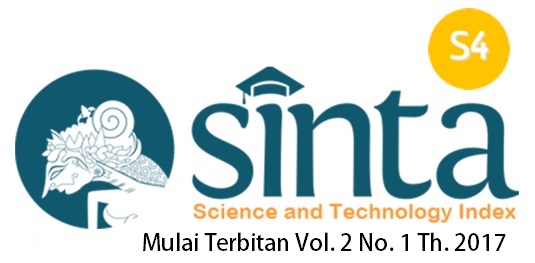PEMBUATAN AREDU SEBAGAI MEDIA PEMBELAJARAN PENINGGALAN MANUSIA PURBA DI SANGIRAN
Abstract
Sangiran is an important site for the development of various fields of science, especially for research in the fields of anthropology, archeology, biology, paleoanthropology, geology, and tourism. The existence of Sangiran site is very useful for studying prehistoric human life because the site is equipped with ancient human fossils, the result of ancient human culture, and ancient fossils of flora and fauna. But in the provision of educational information on the Museum Sangiran still use posters and pamphlets. Therefore necessary to develop educational information media with a more interactive method of Augmented Reality technology.
This application is developed using the method of observation, literature study, interviews with the managers of Sangiran, as well as visitors sangiran questionnaire for data collection, creation of applications such as design, story board, catalogs marker to application development and testing. This research purposes to visualize the prehistory in the multimedia-based Sangiran Museum using Augmented Reality Technology as well as to test the ability of visitors about the discovery of ancient objects in the Museum Sangiran.
The result is that the marker detection by the camera can be optimally if the distance of the camera to the marker between 15-75 cm and a deflection angle between 15o-105o. The results of questionnaires to the application for Aspects of interest that agree and strongly agree is 100%, Aspect Ease ie agree and strongly agree is 96.6%, Aspect Ease of Navigation that is agreed and strongly agreed is 93.4%, ie Interactive Aspects agree and strongly agree is 93.4%, and the aspect of innovation that agree and strongly agree 100%.
Keywords
Full Text:
PDFReferences
Widianto, H., Truman. 2009. “Sangiran Menjawab Dunia “. Sragen Balai Pelestarian Situs Manusia Purba Sangiran.
Widianto, H. 2011. “Nafas Sangiran Nafas Situs-Situs Hominid”. Sragen Balai Pelestarian Situs Manusia Purba Sangiran.
N. Rodrigues, L. Magalhaes, J. Moura, A. Chalmers. 2014. "Digital Applications in Archaeology and Cultural Heritage" 1, 92-102.
L. Gomes, O. R. Pereira Bellon, L. Silva. 2014."3D reconstruction methods for digital preservation of cultural heritage: A survey", Pattern Recognition Letters, 50, 3-14.
R. Stone, T. Ojika. 2002."Virtual Heritage: What Next?" IEEE Multimedia, 73-74.
A. Adamo, P.A. Bertacchini, E. Bilotta, P. Pantano & Tavernise A. 2010."Connecting Art And Science For Education: Learning by an Advanced Virtual Theatre with 'Talking Heads"". Leonardo, 43(5),442-448.
M. Mortara, C. E. Catalano, F. Bellotti, G. Fiucci, M. HouryPanchetti, P. Petridis. 2014. "Learning cultural heritage by serious games", Journal of Cultural Heritage, 15,318-325.
Purnomo, Fendi Aji, dkk. 2014. “Evaluasi Penggunaan Aplikasi Museum Sangiran Berbasis Augmented Reality Dalam Menarik Minat Pengunjung”. Seminar Nasional Teknologi Informasi dan Multimedia. STIMIK AMIKOM, Yogyakarta.
Purnomo, Fendi Aji, dkk. 2015. “Pembuatan Mobile Tour Guide Museum Sangiran Dengan Augmented Reality Berbasis Markerless Tracking”. Jurnal SIMETRIS, 6. 2.
Purnomo, Fendi Aji, Eko Harry P., Roni Abdul Yasir. 2016. “Pembuatan Ruang Pamer 3 Museum Sangiran Menggunakan Teknologi Virtual Reality Berbasis Android”,Simposium Nasional RAPI XV. FT UMS, Solo.
Refbacks
- There are currently no refbacks.






